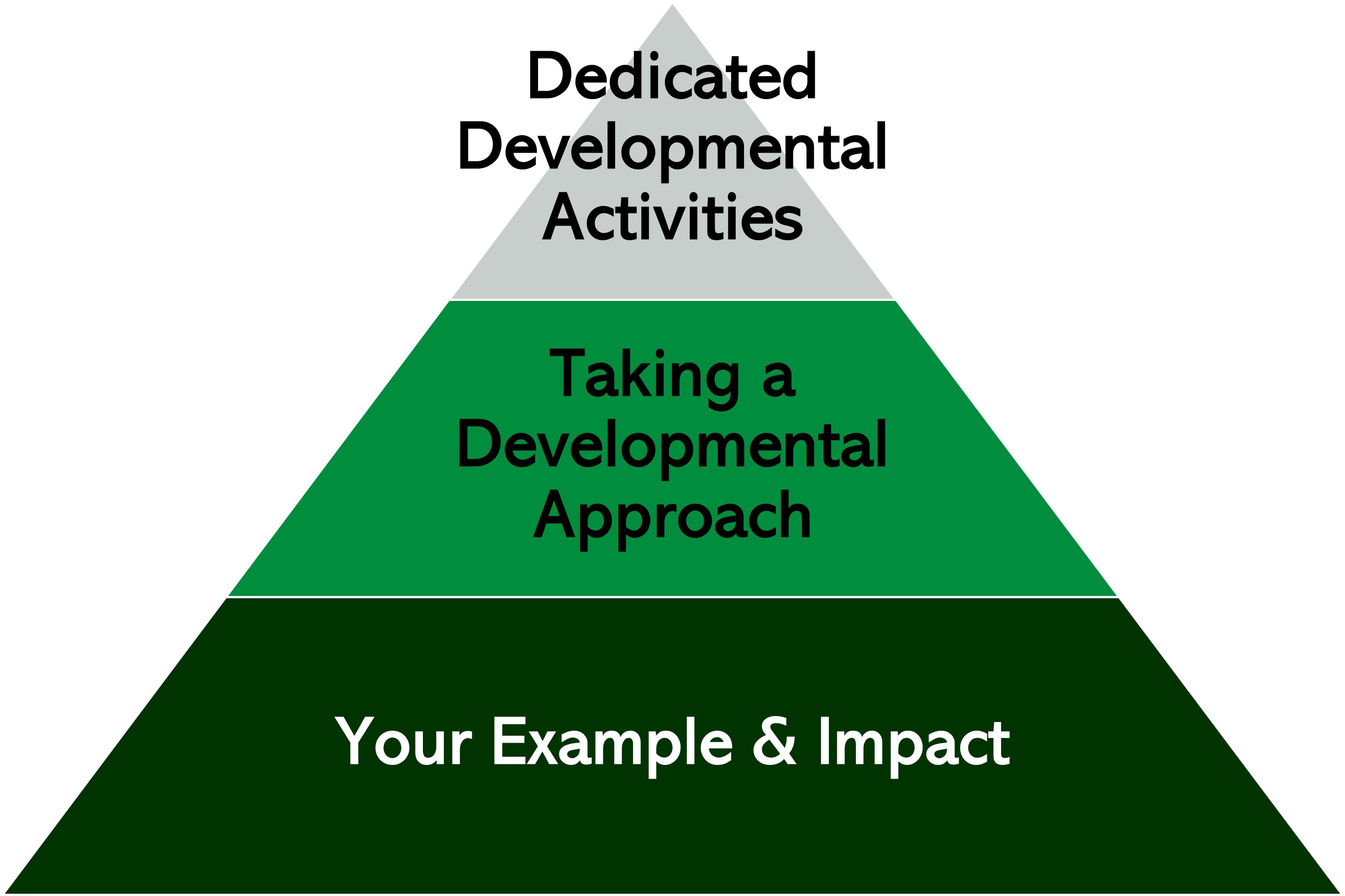Simplifying Leader Development

By: Josh
I am preparing to transition out of a challenging role and a season at work that was defined by long hours, a consistently overwhelming list of tasks and responsibilities, the need to manage organizational issues and urgencies every day, and not enough time accomplish half these things. Though I’m proud of the work our team has done, I also can’t help but feel like I’m leaving the job a bit depleted. And a bit disappointed.
In this season, I found that I was unable to pour into the things about work that I am most passionate about – developing other leaders – nearly as much as I wanted. I didn’t create time and space for intentional conversations around growth and leadership. I felt I hardly spent any time with my people discussing goals, challenges, and feedback. I’m leaving feeling like I failed them, that I didn’t do as much as I should or could to support their leader growth journeys.
So, I feel like I’m transitioning with regrets. I’m excited for my new role and new team, but I feel like I let my current one down.
But I was recently talking with a colleague I trust, respect, and confide in, sharing my feelings of disappointment and regret. He helped me reframe my perspective on the matter, offering an encouraging way to view it.
First, he enabled me to admit that I did the best I could given the time, conditions, and limited capacity I had available. This work environment was hard for all of us, but he knew (and, really, helped me to recognize) that I did what I could with what we had available.
Second, he mentioned an interesting concept, stating that I might not have been able to dedicate as much time as I wanted to developmental activities, but that my mere example – how I led every day – did more than any leadership discussion could have. He encouraged me in saying that I had a bigger impact than I might realize.
While I appreciate my colleague’s optimism and support, I’ve reflected on his comments since our talk. His wisdom also offered a new, simpler approach to leader development.
Simplifying Leader Development
Every bit of developmental content that I consume (books, articles, and podcasts) usually produces a personal sense of urgency for a new behavior, attitude, or approach to leadership that I need to start working on. In just a short amount of time, that can become overwhelming. It can generate pressure that I need to be doing all these things better and start doing them right now. That’s not realistic, nor sustainable.
My colleague’s comments helped me think of a simplified framework for leader development and how we can actually pour into other leaders in at least some small way no matter our circumstances. It’s organized around three broad categories of behaviors: our leader example and impact, taking a developmental approach to how we work, and conducting dedicated developmental activities.

Let’s explore each of these methods.
Leader example and impact. Building other leaders starts with leading ourselves. Tom Watson, former IBM CEO, stated that nothing proves a person’s ability to lead others than what they do on a day-to-day basis to lead themselves first. Our example and how we lead is the first and most essential building block to credibility. It is what first earns us the right to speak truth into other peoples’ lives.
So, what constitutes our leader example? How do have an impact through our leadership? It’s things like:
- Providing purpose, direction, and motivation to the team.
- Cultivating a healthy, effective culture and team cohesion.
- Generating optimism and energy for the team.
- Timely, effective, and transparent decision making.
- Building and maintaining trust through competency, character, and care.
- Creating clear, effective, and efficient team processes that enable peoples’ capacity and success.
- Improving your own self-awareness, self-regulation, and pouring into your own continuous growth as a leader.
Taking a developmental approach. After we become more intentional in how we lead each day, the next step in developing other leaders can be taking a more deliberately developmental approach. This means viewing every moment or event as an opportunity to develop others. It is committing to take the time and effort to maximize someone’s development in a situation, rather than merely dealing with the situation.
Can we take a few extra moments to teach someone how to do something rather than simply doing it for them? Can we be a bit more coach-like, asking a few more questions to enable someone to come to a self-realized solution rather than telling them what they should do? We can be a mentor to offer perspective. We can communicate context and help others understand the broader environment so they can better appreciate how we got to our current circumstance versus communicating “this is just how it is.” It is taking the time to give feedback, explain decisions, and helping others to understand.
This step is often hard for many because of the added time these small actions take. In the busyness of our days, it is enticing to just resolve the issue at hand – making the decision, giving guidance, or doing the task yourself – because it will be easiest and quickest in the moment. But this robs others of the opportunity for development. And small investments of time and effort to be more deliberately developmental with others builds their abilities and capacity over time. Eventually, they become more capable, more self-sufficient, and ready for increased responsibility. They begin to take more ownership. This all ultimately generates more capacity for you as a leader. You spend less time dealing with smaller issues because you’ve built other leaders that have the ability to do it themselves.
Rather than giving someone fish to feed them, through your consistent efforts to take a more developmental approach, you’ve in fact taught them how to fish themselves.
Dedicated developmental activities. Once we have made the effort to be intentional in how we lead and taken the added step to be more developmental in our approaches, if we find that we have the time and capacity for more, we can look to create dedicated developmental activities. These are opportunities where we create time and space for sessions focused on peoples’ individual and collective development. What do we mean by dedicated developmental activities? A few examples can include:
- Educational sessions: Equipping our people with new information or ways of thinking to improve their knowledge, skills, and behaviors. It can be something like teaching the SMART Goals framework to better enable and focus their growth efforts.
- Reflection: Creating space for people to make sense of experiences, thoughts, and emotions. At a personal level, one of my favorite things to do is end certain meetings by having people answer a question on a 3x5 index card. It can be anything relevant to them, you, or the team right now. Even something as broad as, “If I were acting as an intentional leader today, what is the most important thing I would be doing?” Then, follow it up with answering on the back side of the card, “What is preventing me from doing that?” Based on the question, you can collect the index cards. Or you can have people take them with them as a physical reminder of the session. Or you can have people write their response anonymously on a whiteboard after. Collectively, my favorite thing to do is just get the team into a room for 30-60 minutes, break them into small groups, give them whiteboards and markers, and ask them two to four questions to brainstorm on and share with the team after. They can be questions on anything – “Where is our team most successful right now? Where do we need to improve the most?” “Describe (or draw) the ideal ___ teammate (insert your organization’s name).” “Where are we falling short right now?” “List out the values that you see our team living out the most over the last month. How do these compare to our stated team’s values?” As we can see, opportunities abound.
- Team building: There is a variety of activities to purposefully pour into building our team’s cohesion, but the key is being intentional about it. Dedicating the time and space to it and ensuring it is actioned, not ignored, or skipped due to being short on time. These can be simple check-in exercises before a meeting, discussions to build intimacy within our team’s relationships, or opportunities for mutual vulnerability.
Our Example is More Impactful Than We Think
I believe this simplified approach to leader development does several things for us as leaders. First, it can help us better conceptualize our approach to developing others so that we can be more effective and efficient in enacting it. Second, it helps to remove some of the anxiety and worry out of being responsible for developing our people. Looking back at the job that I am transitioning out of now through the lens of this framework helps me to see that I was able to have an impact on my peoples’ development. It might not have been everything I wanted, but it certainly wasn’t as poor as what I was making it out to be.
Third, layering this framework onto some existing research actually shows us that our example as a leader may be more impactful than we think. Consider the 70-20-10 Model developed in the 1990s, which finds that people learn from three types of sources, each with associated ratios. It reports that 70% of peoples’ learning comes from challenging experiences and assignments, most commonly associated with on-the-job training and experiences. 20% comes from developmental relationships like mentorship and coaching. And the last 10% comes from structured learning opportunities like courses and lectures.
When we consider our three steps of developing leaders, they match well with the 70-20-10 Model. Our example and impact directly contribute to peoples’ experiences, which constitutes 70% of their learning and growth. Our deliberately developmental approaches enable the 20% of learning through things like mentorship and coaching. And then our dedicated developmental activities plug into that remaining 10% of structured learning.
So, don’t underestimate the impact of your leadership and your example. Even just this first step will likely do more for your peoples’ development than any other thing you do.
Closing Thoughts
If we are in a new leadership or management role, or we have recently come to a place where we are considering how we ought to pour into our people more, I believe this tiered approach to leader development can simplify, focus, and inspire your actions.
Our example and how we lead has a bigger impact than we may ever know. It’s how we build credibility and the right to speak truth into other’s lives. It’s how we build opportunity for more developmental approaches and dedicated developmental activities. And how we get others to care about them.
So, what is one thing we can do today or this week to be more intentional in how we lead?
Where is the easiest opportunity for me to begin taking a more developmental approach with others?
Which area of this simplified leader development model needs the preponderance of my attention right now? Where can I have the biggest impact?





